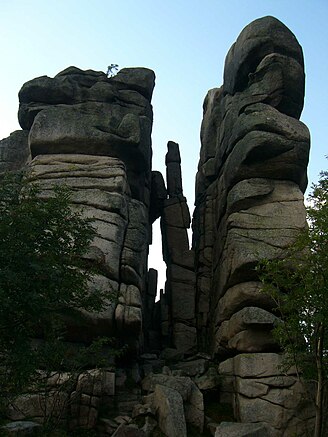Kukułcze Skały
| Kukułcze Skały cuckoo stones and pendulums |
|
|---|---|
| - | Basic geotopic data |
| Geotope type | Granite outcrop |
| Terrain height | 1110 m |
| Size (L × W × H) | approx. 15 m × 12 m × 14 m |
| location | Lower Silesia , Poland |
| Geological unit (s) | Silesian ridge → Giant Mountains |
| Municipality / city | Szklarska Poręba ( Schreiberhau ) |
| Coordinates | 50 ° 47 '28.2 " N , 15 ° 31' 56.9" E |
Kukułcze Skały (German cuckoo stones , Czech Kukaččí skály ) is the Polish name for a rock formation made of granite in the western part of the Silesian Ridge of the Giant Mountains in Poland .
location
The rock group lies at an altitude of 1110 meters above sea level, on the northern slope of the Veilchenstein ( Łabski Szczyt in Polish , Violík in Czech - 1472 m). Crow 3,5 km from Szklarska Poreba ( Schreiberhau ) away.
The special thing about the cuckoo stones is the “pendulum” (Polish : Wahadło ), a slender, almost free-standing rock needle about seven meters high that seems to be wedged between the walls of two rock towers that are about twice as high. Stronger winds should be able to move the pendulum, which, however, belongs to the legends that have also formed here around the bizarre rock shapes.
Emergence
Along the Silesian Ridge you come across a number of these rock outcrops , including the cuckoo stones. If, as in this case, they are below the tree line, they only became clearly visible from the valley after the spruce forests had died down due to air pollution .
What they all have in common is the way in which they originate as a result of lengthy geological processes. Before the igneous rock body of the Giant Mountains could reach the surface, the rock layers above had to be removed by denudation . The now exposed deep rock was then exposed to further erosive forces .
These influences were particularly strong during the last ice age . Freezing water between the cracks in the rock blasted the material and created the typical, strongly rounded rock shapes corresponding to what is known as wool sack weathering . The crushed rock was carried away by a phenomenon called "soil flow" . This explains why the rocks as outcrops - to put it in layman's terms - remained isolated. Geomorphologically, the rock formation is assigned to the Tor type (it is named after the rock towers called Tors in Dartmoor / England ).
tourism
Nearby is the "Old Silesian Baude". From there, a yellow-marked hiking trail, coming from Schreiberhau, leads to the rocks and on towards Śnieżne Kotły ( Snow Pits ). A rest area has been set up at the foot of the rocks, from where you can enjoy the picturesque view of Schreiberhau, the Reifträger and the Jizera Mountains . Although the area belongs to the Polish national park Karkonoski Park Narodowy (KPN), the rock group is designated as a climbing rock.
A larger climbing area is only around 800 meters away outside the nature reserve. However, the Borówczane Skały ( Bräuerhansen's stones ) are not open to tourists. No marked path leads there, which is probably intended for nature conservation reasons.
Web links
Individual evidence
- ↑ a b OpenStreetMap
-
↑ Cuckoo stones and pendulums ( Memento of the original dated January 2, 2016 in the Internet Archive ) Info: The archive link was inserted automatically and has not yet been checked. Please check the original and archive link according to the instructions and then remove this notice. (Polish side) Occasionally, the debris field from smaller boulders in the area is included, so other sources may give different heights.
- ↑ Rock towers (Giant Mountains season)
- ↑ From a path database for sport climbers
